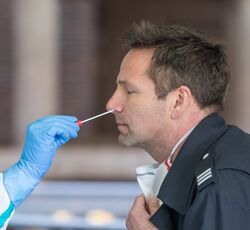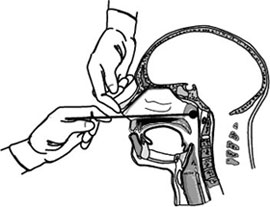PCR method
(Medical method) | |
|---|---|
 | |
| Start | 1983 |
| A standard DNA-amplification method in medical laboratories, but misused to create a false pandemic during the COVID-19 deep event. | |
Polymerase chain reaction (PCR) is a method widely used to rapidly make millions to billions of copies (complete copies or partial copies) of a specific DNA sample, allowing scientists to take a very small sample of DNA and amplify it (or a part of it) to a large enough amount to study in detail.
Contents
Overview
PCR was invented in 1983 by the American biochemist Kary Mullis at Cetus Corporation. It is fundamental to many of the procedures used in genetic testing and research, including analysis of ancient samples of DNA and identification of infectious agents. Using PCR, copies of very small amounts of DNA sequences are exponentially amplified in a series of cycles of temperature changes. PCR is now a common and often indispensable technique used in medical laboratory research for a broad variety of applications including biomedical research and criminal forensics.[1]
Problems
The PCR method, which takes a small sample of DNA and doubles it for each amplification, will after a certain number of doubling create more and more errors.
As the inventor Kary Mullis himself stated:
PCR is just a process that allows you to make a whole lot of something out of something. It doesn’t tell you that you are sick, or that the thing that you ended up with was going to hurt you or anything like that.[2]
Covid-19

The PCR test developed by Christian Drosten for SARS has been a core element in creating the COVID-19 deep event. Described in the media as the “gold standard” for Covid diagnosis, PCR tests for Covid are known to produce a lot of false-positive results, by reacting to DNA material that is not specific to Sars-Cov-2.[3]
A Chinese study found the same patient could get two different results from the same test on the same day[4]. In Germany, tests are known to have reacted to common cold viruses[5]. A 2006 study found PCR tests for one virus responded to other viruses too[6]. In 2007, a reliance on PCR tests resulted in an “outbreak” of Whooping Cough that never actually existed[7]. Some tests in the US even reacted to the negative control sample[8].
Amplification cycles
Another thing that contributes to the immense amount of false positive results when required for political reasons, is that by adjusting the number of amplification cycles the amounts of false positives could be increased or decreased at will. Doubled 25 times the starting unit is increased to 33 million times; if set at 40 times, the starting unit has replicated a trillion times, making the result scientifically meaningless.[9]
Kary Mullis said: “If you have to go more than 40 cycles[…]there is something seriously wrong with your PCR.”[10]
For some reason - that is still hasn't been explained properly - the Drosten-test has to be stuck in the back of the nasal passage, near the blood-brain barrier), potentially damaging a very sensitive area of the body.
Dr Juliet Morrison, virologist at the University of California, Riverside, told the New York Times: Any test with a cycle threshold above 35 is too sensitive…I’m shocked that people would think that 40 [cycles] could represent a positive…A more reasonable cutoff would be 30 to 35″. Dr Michael Mina, of the Harvard School of Public Health, said the limit should be 30, and the NYT points out that reducing the CT from 40 to 30 would have reduced “covid cases” in some states by as much as 90%.[11]
Despite this, it is known almost all the labs in the US are running their tests at least 37 cycles and sometimes as high as 45[12]. The NHS “standard operating procedure” for PCR tests rules set the limit at 40 cycles.
Questionable genome sequence
The scientific basis for Covid tests is questionable. The genome of the Sars-Cov-2 virus was supposedly sequenced by Chinese scientists in December 2019, then published on January 10th 2020. Less than two weeks later, German virologists (Christian Drosten et al.) had allegedly used the genome to create assays for PCR tests.
Drosten and his co-authors published their paper on the: "Detection of 2019 novel coronavirus (2019-nCoV) by real-time RT-PCR" in the journal Eurosurveillance on 23rd January, 2020.[13] Drosten and one co author are also a members of the board at Eurosurveillance. The conflict of interest section of the paper had to be updated on 29th July, 2020 - and the the submission date and acceptance date are January 21st and January 22nd, respectively. Leaving strong doubt that the paper had any peer review at all, which let the team of the Corman-Drosten Review Report, among whom Michael Yeadon was a collaborateur, to issue a retraction letter to Eurosurveillance.[14] Their concerns were brushed away by members of Eurosurveillance later on.
In November 2020, a consortium of over forty life scientists has petitioned for the withdrawal of the paper[15], writing a lengthy report detailing 10 major errors in the paper’s methodology. They have also requested the release of the journal’s peer-review report, to prove the paper really did pass through the peer-review process. They have had no reply by September 2021.
Related Quotations
| Page | Quote | Author |
|---|---|---|
| Theodore Dalrymple | “The British government has managed to spend approximately $50 billion on a system for testing and tracing cases of COVID-19. So far, the average citizen has been tested five times. Yet mysteriously, the British mortality rate is either above, or very similar to, that of countries that have tested and traced much less often. A parliamentary commission reported that there was no evidence that the whole system had had any beneficial effect whatever. This was a very hasty and naive conclusion. It assumed, for example, that the real object of the system was to prevent illness and save lives. But if one puts aside this facile prejudice, one may come to the conclusion that it was an enormous success, for—in now traditional fashion—it shoveled enormous quantities of public money into private pockets, no doubt seriously enriching large numbers of people. If one assumes that the purpose of the expenditure was to create or reward a clientele class, not only does everything become clear, but it changes one’s opinion as to whether or not the whole thing was a success—in its own terms, of course.” | Theodore Dalrymple |
| Anthony Fauci | “Guys like Fauci get up there and start talking, and he doesn’t know anything really about anything, and I’d say that to his face. Nothing. He doesn’t understand electron microscopy and he doesn’t understand medicine...
Most of those guys up there on the top are just total administrative people and they don’t know anything about what’s going on with the bottom. You know, those guys have got an agenda, which is not what we would like them to have, being that we pay for them to take care of our health in some way... They’ve got a personal kind of agenda. They make up their own rules as they go. They change them when they want to and a smugly like Tony Fauci does not mind going on television in front of the people, face out, and lie directly into the camera.” | Anthony Fauci Kary Mullis |
References
- ↑ "Polymerase Chain Reaction (PCR)"
- ↑ https://off-guardian.org/2020/10/05/pcr-inventor-it-doesnt-tell-you-that-you-are-sick/
- ↑ This section is based on compilations from OffGuardian + Swiss Policy Research https://off-guardian.org/2021/09/22/30-facts-you-need-to-know-your-covid-cribsheet/#comments
- ↑ https://pubmed.ncbi.nlm.nih.gov/32219885/
- ↑ https://www.schwerin.de/news/4a3e5560-78c9-11ea-b543-1967de695b51/
- ↑ https://www.ncbi.nlm.nih.gov/pmc/articles/PMC2095096/
- ↑ https://www.nytimes.com/2007/01/22/health/22whoop.html
- ↑ https://www.science.org/news/2020/02/united-states-badly-bungled-coronavirus-testing-things-may-soon-improve
- ↑ "Effective amplification of long targets from cloned inserts and human genomic DNA"
- ↑ Mullis statement
- ↑ https://www.nytimes.com/2020/08/29/health/coronavirus-testing.html
- ↑ https://www.nytimes.com/2020/08/29/health/coronavirus-testing.html
- ↑ https://www.eurosurveillance.org/content/10.2807/1560-7917.ES.2020.25.3.2000045
- ↑ https://cormandrostenreview.com/retraction-request-letter-to-eurosurveillance-editorial-board/
- ↑ https://cormandrostenreview.com/report/